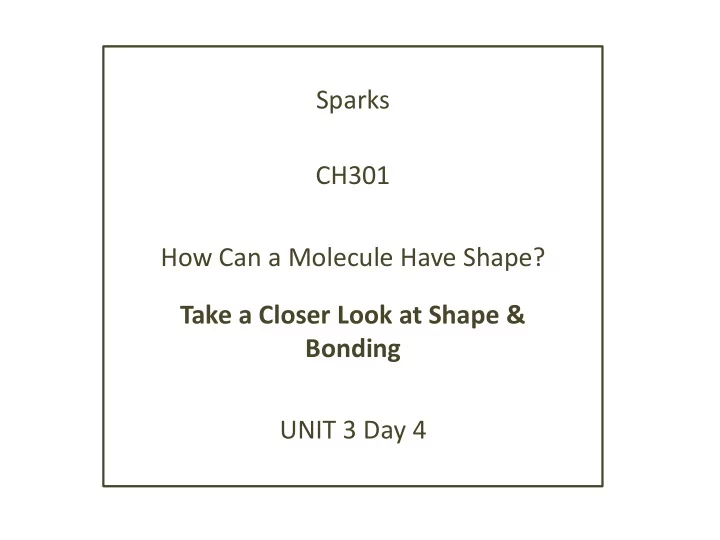

Sparks CH301 How Can a Molecule Have Shape? Take a Closer Look at Shape & Bonding UNIT 3 Day 4
What are we going to learn today? Understand Bonding Theory Supporting Experimentally Determined Shapes (VB Theory - σ and π bonds)
Quiz: Clicker Questions 1. What is the electron configuration of N? A. 1s 2 2s 2 2p 3 C. 1s 2 2s 2 2p 2 B. 1s 2 1p 6 2s 2 2p 3 D. 1s 2 2s 2 2p 6 2. What is the shape of NH 3 ? A. Tetrahedral C. Trigonal pyramidal B. Trigonal planar D. T-shaped Think about bond angles in NH3. How get that bonding from the original s and p orbitals?
Atomic Orbitals Molecular Shape How is it that we get from atomic orbitals with characteristic shapes to these bonds? Overlapping orbitals – H 2 HF
Valence Bond Theory (VB) • H-H bond, s – s , “head on” overlap yields sigma bond • H-F bond, s-p , “head on” overlap yields sigma bond
Think about methane – CH 4 2s 2 2p 2 overlapping with 1s 1 How is that possible?
Make “new” atomic orbitals that are combinations of the “old” orbitals. We call these “hybrids” one 2s + three 2p’s = four sp 3
Poll: Clicker Questions • Describe the “new locations” of the N valence electrons we use to describe bonding in NH 3 according to VB theory. A. A pair of electrons in the 2s orbital and 3 sp 2 orbitals, each singly occupied. B. Four sp 3 orbitals, each singly occupied. C. Four sp 3 orbitals, three singly occupied and one with a pair of electrons. D. Five sp 3 orbitals, each singly occupied.
NEW HYBRIDIZED ORBITALS ARE DEGENERATE!
EXPLAIN BONDING FOR AMMONIA
Use hybridization to explain the trigonal planar arrangement: for example BF 3
Use hybridization to explain the trigonal planar arrangement: for example BF 3
When one s and two p oribitals are mixed to form a set of three sp 2 orbitals, one p orbital remains unchanged and is perpendicular to the plane of the hybrid orbitals.
USE VB THEORY TO EXPLAIN BONDING IN ETHENE
VB multiple bond • Ethene has a C = C double bond
LABEL THE SIGMA AND PI BONDS
USE VB THEORY TO PREDICT BONDING IN ETHYNE
USE VB THEORY TO PREDICT BONDING IN ETHYNE When one s orbital and one p orbital are hybridized, a set of two sp orbitals oriented at 180 degrees results two p orbitals “left over” for making pi bonds. Examples of sp hybridization: N 2 , HCCH, CO 2
Hybridization of orbitals for CO 2
(a) An sp hybridized nitrogen atom (b) The σ bond in the N 2 molecule (c) the two π bonds in N 2 are formed
Hybridization for expanded valence
You can match VB with VSEPR
WHAT HAVE WE LEARNED TODAY? The molecular shapes can be explained using Valence Bond Theory - Hybridized Orbitals.
Important Information DUE Monday: LM21 HW
Recommend
More recommend